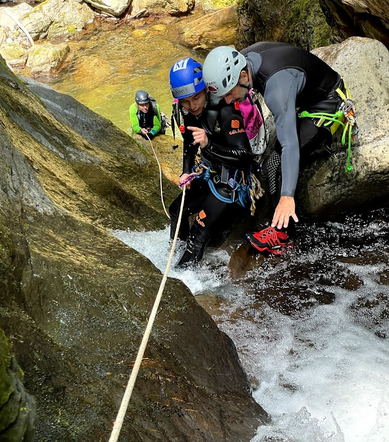Canyon Leadership
Introduction
Our Canyon Leaders and Instructors are all volunteers who have been mentored by others in the community and are excited to pay it forward. All of our Leaders first serve as Assistant Leaders, and complete both technical assessments and mentored leads before leading groups in-canyon. Not only does leading and instructing benefit our community, it provides new growth opportunities for the leader. We have a strong community of Canyon Leaders, who dedicate time every year to personal growth in more challenging canyons together, making them stronger leaders, and more connected as a community of leaders.
Leaders
Leaders must be approved to lead Canyons by the sponsoring committee, and must be vetted according to the following standards:
Assistant Canyon Leader
Qualifications::
- Complete Application
- Intermediate Canyon Course or Equivalency
- Descent of 15 unique aquatic canyons
- Participation on 2 Mountaineers canyon trips that are not part of a course
- Wilderness First Aid training
- Completion of online course and assessment
- Pass Assistant Canyon Leader Technical Assessment
Lead Instructor
- Assistant Leader or Leader Status
- Note: a Leader must be present on the in-canyon days
- 5 unique aquatic canyons in the past 12 months
Canyon Leader
Requirements:
- 18+ years of age
- Intermediate Canyon Course or equivalency
- Pass Assistant Canyon Leader Assessment
- 15+ aquatic canyon descents, 10 unique canyons
- 5 Mountaineers canyon trips as Assistant Leader -OR- 5 non-Mountaineers canyon trips as a leader
- Wilderness First Aid training
- Minimum of 2 mentored leads with different leaders
- Ability to swim 25 meters without buoyancy, 4 meters under water
- Ability to jump 2 meters vertically into water
- Committee vote of approval
Skills:
- Movement: Canyon Leaders demonstrate safe movement ascending, descending and traversing canyon terrain including: steep ground, uneven terrain, ridges, gullies, slippery terrain and easy rock steps.
- Navigation: Canyon Leaders are proficient in off-trail navigation, have an understanding of and ability to identify the watershed of a creek, and are able to use a variety of navigational tools to find their way to a canyon, through a canyon, and out of a canyon. Canyon leaders are also proficient at route selection while navigating canyon terrain, including avoiding unnecessary obstacles such as hydraulics and unstable terrain.
- Personal and Group Risk Management: Canyon Leaders are proficient in a variety of risk management protocols including rigging and rope management, bag management, proper sequencing of rappellers, monitoring party member disposition, and emergency planning.
- Group Planning & Logistics: Canyon Leaders adequately plan and prepare themselves and participants for the outing, including communicating expectations and requirements. Canyon Leaders monitor conditions leading up to the outing and anticipate participant needs, communicating regularly with participants in advance of the outing.
- Organization and group leadership: Canyon Leaders communicate with participants before the trip, at the trailhead, and during the trip, including checking on participant well-being, defining clear roles and responsibilities, and changing plans as necessary.
- Defensive swimming: Canyon Leaders can identify, analyze and assess water hazards in a canyon. Canyon Leaders can navigate water hazards as the first person down, and can use rigging and other techniques to divert participants from the hazard as needed.
- Basic rope work: Canyon Leaders are proficient at using semi-static and static ropes, rappelling single-strand or double-strand as needed for the situation, utilizing variable friction devices, ascending and descending ropes, employing techniques for managing rope abrasion, rigging retrievable traverse lines , rigging fixed and releasable rappels, and proper use of rope bags.
Tactics and strategy
- Emergency procedures: Canyon Leaders are able to assess an emergency situation in the context of the canyon. They have an emergency action plan which considers communication techniques, evacuation options, escape options, and roles and responsibilities within the party.
- First aid: Canyon Leaders have first aid training, and are able to assess a scene, recognize and treat hypothermia, cold injury & heat disorders, stabilize an injury, provide remote care including overnight, and direct party members to call for assistance and perform tasks that maintain the safety of the groups.
- Camping and bivouacs: Canyon Leaders adequately plan for and are able to facilitate a bivouac if necessary.
Knowledge:
- Hazards: Canyon Leaders are able to assess terrain and weather hazards as well as any wildlife that may present a danger in that region. Canyon Leaders understand basic hydrology, topology and geology in the context of hazards that may be present in a canyon, including: the existence of heavy flow or hydraulics, the absence or presence of escape routes, the rock quality and attributes of the canyon, and the access to high ground within a canyon.
- Protocols: Canyon Leaders are fluent in communication protocols including hand signals and whistle signals. Canyon Leaders understand general security protocols including canyon progression, anchor rigging and assessment, rope management, and group management.
- Emergency procedures: Canyon Leaders understand The Mountaineers emergency procedures.
- Trip Management: Canyon Leaders understand The Mountaineers protocols for managing accurate rosters on the website, listing and closing trips, and filing incident reports as needed.
- Land manager protocols: Canyon Leaders know where to find Land Manager regulations for a given canyon and understand the importance of following them.
- Legal liability & insurance: Canyon Leaders understand the following: The Mountaineers provides liability insurance for its leaders as long as a trip is listed on The Mountaineers website with an accurate roster; The Mountaineers requires all participants to sign a waiver before they can register for a trip; The Mountaineers does not provide accident insurance for participants or leaders.
Leaders are expected to lead Canyons within their ability, to maintain their leadership and technical skills through regular practice and training, and to be up to date in current Canyoning skills & techniques taught by The Mountaineers.
